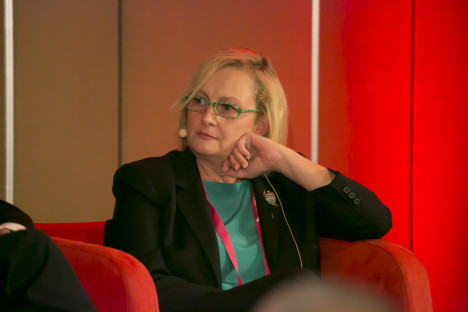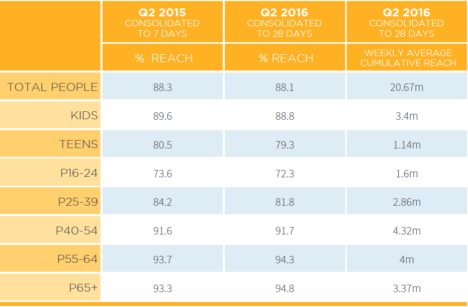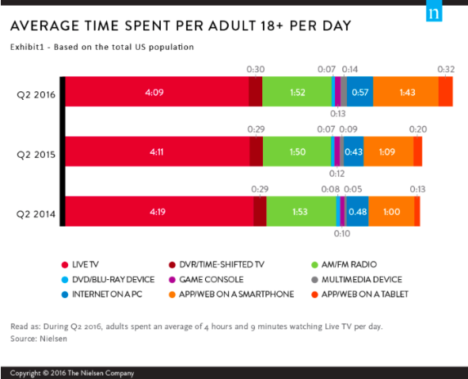Here’s why reports of TV’s demise are overstated
In this guest post ThinkTV CEO Kim Portrate argues the latest figures show TV is still the dominant media for marketers to achieve scale on.
“Demise”, “plummet”, “grim”: if you took some of last week’s coverage of the Multi-Screen Report literally you could make believe that today’s TV was headed the way of the cathode ray tube.
Now ThinkTV loves a good local drama as much as the next guy. But we think it’s time to exhale, turn off hype-machine and take a bit of a reality check, people.
Yes, viewing habits are changing – and the latest Multi-Screen Report gave us ample evidence of these irrefutable facts. Demographics under 50 watched a bit less broadcast TV than they did last year, which is actually a little surprising given the plethora of other choices currently on offer.
But let’s look at where some of the stats actually sit on the “grimness” index, and then head to the US – from where we tend to take our lead in terms of media trends – for a hint of what may follow.
According to the Multi-Screen Report, Australian broadcast TV’s average weekly cumulative reach fell from 84.2% reach in the second quarter last year to 81.8% this year in the 25-39 bracket.
A lot has already been said about this statistic. But here are two that haven’t yet seen much light of day: 1. Reach only fell 2.4 percentage points and, 2. Even with the change, advertisers can still reach more than eight out of ten 25-39-year-olds every week via TV.
It’s a timely reminder that TV has unbeatable scale and reach compared to every other media, including for the most-valued audiences, whose viewing TV still dominates compared to online video.
The report also reminded us that today’s TV is everywhere, any time and multi-platform. TV is moving to meet its audiences and has been since the first catch up services launched in 2008. (You may be reading this on your mobile which, thanks to the innovations of recent years, is actually a TV too).
Meanwhile, new stats from OzTAM and RegionalTAM show that TV reached more than 16 million Australians every day in the second quarter of 2016.
That bears repeating: more than 16 million Aussies every day. The same Aussies that grocery shop, buy clothes and cars, go to the movies and make phone calls. If you’re an advertiser these are the people you want to connect with.
It takes one social media platform you’ve been reading a lot about lately a whole month to reach 15 million of them. A month?
Now don’t get me wrong TV works brilliantly with other media and we know that there is a place for all in the modern media landscape. Social media and online advertising platforms have undeniable qualities that appeal to advertisers (not least their irresistible synergies with campaigns that run on TV).
But the big thing they lack is the viewability of TV, where 100% of the ad is viewable on 100% of the screen, 100% of the time – and there’s no worries about distractions or bots.
Debate about how many people watch TV in the ad breaks is not new either, so why would we assume that video ads online don’t exactly face the same challenge. Maybe it’s the same but we’re just not ready to talk about it?
And while that particular social platform we mentioned is busy pulling its pants up after doing what was at best a big video-measurement whoopsie, buyers of Australian TV ad slots can sleep soundly tonight knowing that this industry has never marked its own homework.
OzTAM’s third-party measurement panel is not only the gold standard for independence, it will also increase by 50% each next year, making it the largest per capita people metered market in the world.
None of which is to suggest that TV has any reason to be arrogant. Like all media, including social, it faces challenges.
One of the most discussed is that subscription video-on-demand is becoming increasingly popular, particularly with Millennials and other younger demographics.
What then, is the real volume of SVOD viewing among mass audiences, and therefore the likely cannibalisation of TV viewing?
Think about that for a minute, six people in 100 do almost 90% of video streaming.
You can bet they talk about it a lot too.
And here’s the rub: “In addition to their streaming habits, these power streamers are watching more than four hours of TV per day,” according to VAB.
This stat confirmed something we learned from a BARB report out of the UK last year, which stated that many SVOD devotees are, “not to put too fine a point on it, inveterate telly addicts”.
Nielsen’s Total Audience study from the US from last week tells a similar story, and it is a critical one for advertisers to hear.
“Consumers continue to desire and seek options when it comes to content,” writes Nielsen. “But in the expanding world of smart devices and the seemingly endless amount of sites and apps available, traditional means of media still hold their own.”
I’d disagree with one small bit of that: today’s TV is definitely not traditional, it’s everywhere all of the time.
And we don’t pretend for a minute to know exactly where all of this change is ultimately heading. But we do know that a marketer wanting to sell a product in today’s market is looking at today’s reality.
And the reality is that when it comes to reach, scale, measurability, trustworthiness and view-ability, TV still wins. Every time.
Kim Portrate is a chief executive at ThinkTV






So hyperbole from both sides of the aisle now then?
The fact is that there is nobody out there in planning land who is arguing that TV is not a great way to drive mass rapid reach. But the fact is that consumer behavior is gradually changing and just as importantly the tools at our disposal measure said change are developing too. The upshot being any planner worth his/her salt has recognized that whilst TV is vital to drive reach they can drive incremental reach by employing digital video alongside it.
The fact is that we as planners are rarely viewing any given channel in isolation, as Kim notes in her piece its about how these channels can work together.
But I must say these pieces as defensive as they are fail if their role was to dampen down the initial Mumbrella reaction to the Multi-screen Report – which was always going to be laced with its normal degree of sensationalism.
And please please please in the name of all the is holy don’t bring up the Viewability argument – it’s one you simply cannot support. No worries about distractions? Second / thirds screens anyone? Its in the same report for heavens sake.
there used to be a book ( a few copies still exist) called the little red book of opera singing. In the book, there were chapters devoted to the art of opera singing, including a section on “how to do it,” each contributed by a leading opera singer of the time. On reading the book, one was surprised to discover that each of the contributors gave a different account of the facts and each wrote with absolute authority; one fellow ( a baritone at the Metropolitan ) insisted that he was the only person in the entire book who actually knew everything about the subject.
Television as we know is certainly savable, but it will soon die. The reasons are but a few, and they all have to do with quality of production and style.
The diminishing number of golden eggs will stop entirely, because the money men, forever chasing ratings, will very soon kill the goose.
Oh wow, television will soon die! Can I watch? What channel will it be on?
ummmm… what?
YouTube or Facebook